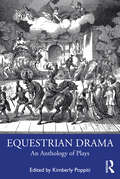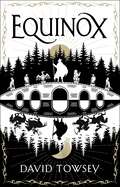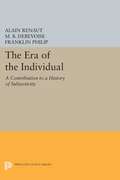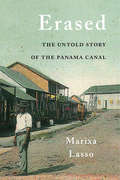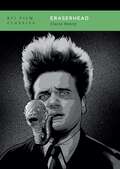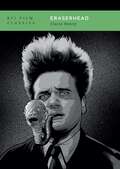- Table View
- List View
Equestrian Drama: An Anthology of Plays
by Kimberly PoppitiEquestrian Drama: An Anthology of Plays is a collection of four representative equestrian dramas. It includes four annotated plays: Timour the Tartar by Matthew G. Lewis, The Battle of Waterloo by J. H. Amherst, Mazeppa by Henry M. Milner, and The Whip by Henry Hamilton and Cecil Raleigh. An introduction precedes the collection, providing the information necessary to understand and contextualize the genre and the plays as both written and performance texts, and within the time period of their original productions, as well as within the larger histories of theatre and equestrian entertainments. Additional related plays are identified, excerpted, and explored, providing readers with a wide range of examples to better understand the development and significance of this unique form of popular theatre. Also identified and explored are significant contributions made to stage technology and design by the patented stage machinery designed for the production of the mechanized form of equestrian drama, which became popular in the late nineteenth century. Equestrian Drama is suitable for undergraduate, graduate, and professional students in theatre history, dramatic literature, performance studies, and equine studies. An online supplement to this book is available to provide readers with additional content relating to this collection, including original English language translations of La Fille Hussard and Rognolet and Passe-Carreau, as well as the full annotated text of Turpin's Ride to York.
Equiano's Travels
by Olaudah EquianoThe most famous slave memoir of the 18th century. Equiano's Travels recounts the extraordinary life and times of Olaudah Equiano, from his early life in Africa to his struggle for freedom in the West Indies. 'I who had been a slave in the morning, trembling at the will of another, was become my own master, and completely free.' Olaudah Equiano was only eleven when he was kidnapped from the Kingdom of Benin. His report on the horrors that followed whilst imprisoned on slave ships and on land offers a rare and significant insight into the realities of the transatlantic slave trade.First published in London in 1789, Equiano's memoirs were an instant success and paved the way for the abolition of slavery in the British Empire.Abridged and edited by Paul Edwards.'A powerful and terrifying read.' Guardian 'Central to our understanding of Atlantic slavery.' The Times 'A gripping account from 1789 of life as a slave.' New York Times
Equilibrium and Evolution: Alfred Marshall and the Marshallians
by N. HartAlfred Marshall has traditionally been listed alongside pioneering 'neoclassical' economists. In this volume Neil Hart challenges this view, illuminating the ambiguities within Marshall's work, and exploring his reconciliation of two modes of thinking, equilibrium economics and evolutionary economics.
Equinox
by David TowseyIn this world, two souls inhabit a single body, one by day, one by night. But though they live alongside one another, their ends do not always align. For Special Inspector Morden, whose hunt for a dangerous witch takes him far from home, this will be a problem...Christophor Morden lives by night. His day-brother, Alexsander, knows only the sun. They are two souls in a single body, in a world where identities change with the rising and setting of the sun. Night-brother or day-sister, one never sees the light, the other knows nothing of the night.Early one evening, Christophor is roused by a call to the city prison. A prisoner has torn his eyes out and cannot say why. Yet worse: in the sockets that once held his eyes, teeth are growing. The police suspect the supernatural, so Christophor, a member of the king's special inspectorate, is charged with finding the witch responsible.Night-by-night, Christophor's investigation leads him ever further from home, toward a backwards village on the far edge of the kingdom. But the closer he gets to the truth, the more his day-brother's actions frustrate him. Who is Alexsander protecting? What does he not want Christophor to discover?And all the while, an ancient and apocalyptic ritual creeps closer to completion...Praise for Equinox:'Clever, original and beautifully crafted, half the fun here lies in getting to grips with the ramifications of this complex world, but the story holds like a vice' Daily Mail 'Spellbinding fantasy... This innovative work is sure to please' Publishers Weekly 'An ambitious and gruesome tale of intrigue, witches, and the warring self – utterly transporting' Ian Green, author of The Gauntlet and the Fist Beneath
Equipping James Bond: Guns, Gadgets, and Technological Enthusiasm
by Andr © MillardThe popularity of the 007 franchise depends on a seductive formula of sex, violence, and snobbery. Much of its appeal, too, lies in its gadgets: slick, somewhat improbable technological devices that give everyone;€™s favorite secret agent the edge over his adversaries. In Equipping James Bond, Andr;© Millard chronicles a hundred-year history of espionage technology through the lens of Ian Fleming;€™s infamous character and his ingenious spyware. Beginning with the creation of MI6, the British secret service, Millard traces the development of espionage technology from the advanced weaponry of the nineteenth century to the evolving threat of computer hacking and surveillance. Arguing that the gadgets in the books and films articulate the leading edge of technological awareness at the time, Millard describes how Bond goes from protecting 1950s England from criminal activity to saving a world threatened by nuclear bombs, poison gas, and attacks from space. As a modern and modernizing hero, Bond has to keep up with the times. His film franchise is committed to equipping both Bond and his adversaries with the latest technological gadgets. Simultaneously, Millard stresses, the villains and threats that Bond faces embody contemporary fears about the downside of technological change. Taking a wide-ranging look at factual (and fictional) technology, Millard views the James Bond universe as evidence for popular perceptions of technological development as both inevitably progressive and apocalyptically threatening.
Equipping James Bond: Guns, Gadgets, and Technological Enthusiasm
by Andr © MillardThe popularity of the 007 franchise depends on a seductive formula of sex, violence, and snobbery. Much of its appeal, too, lies in its gadgets: slick, somewhat improbable technological devices that give everyone;€™s favorite secret agent the edge over his adversaries. In Equipping James Bond, Andr;© Millard chronicles a hundred-year history of espionage technology through the lens of Ian Fleming;€™s infamous character and his ingenious spyware. Beginning with the creation of MI6, the British secret service, Millard traces the development of espionage technology from the advanced weaponry of the nineteenth century to the evolving threat of computer hacking and surveillance. Arguing that the gadgets in the books and films articulate the leading edge of technological awareness at the time, Millard describes how Bond goes from protecting 1950s England from criminal activity to saving a world threatened by nuclear bombs, poison gas, and attacks from space. As a modern and modernizing hero, Bond has to keep up with the times. His film franchise is committed to equipping both Bond and his adversaries with the latest technological gadgets. Simultaneously, Millard stresses, the villains and threats that Bond faces embody contemporary fears about the downside of technological change. Taking a wide-ranging look at factual (and fictional) technology, Millard views the James Bond universe as evidence for popular perceptions of technological development as both inevitably progressive and apocalyptically threatening.
Equity Capital: From Ancient Partnerships to Modern Exchange Traded Funds (Routledge International Studies in Business History)
by Geoffrey PoitrasCapitalism is historically pervasive. Despite attempts through the centuries to suppress or control the private ownership of commercial assets, production and trade for profit has survived and, ultimately, flourished. Against this backdrop, accounting provides a fundamental insight: the ‘value’ of physical and intangible capital assets that are used in production is identically equal to the sum of the debt liabilities and equity capital that are used to finance those assets. In modern times, this appears as the balance sheet relationship. In determining the ‘value’ of items on the balance sheet, equity capital appears as a residual calculated as the difference between the ‘value’ of assets and liabilities. Through the centuries, the organization of capitalist activities has changed considerably, dramatically impacting the methods used to value, trade and organize equity capital. To reflect these changes, this book is divided into four parts that roughly correspond to major historical changes in equity capital organization. The first part of this book examines the rudimentary commercial ventures that characterized trading for profit from ancient times until the contributions of the medieval scholastics that affirmed the moral value of equity capital. The second part deals with the evolution of equity capital organization used in seaborne trade of the medieval and Renaissance Italian city states and in the early colonization ventures of western European powers and ends with the emergence in the market for tradeable equity capital shares during the 17th century. The third part begins with the 1719-1720 Mississippi scheme and South Sea bubbles in northern Europe and continues to cover the transition from joint stock companies to limited liability corporations with autonomous shares in England, America and France during the 19th century. This part ends with a fundamental transition in the social conception of equity capital from a concern with equity capital organization to the problem of determining value. The final part is concerned with the evolving valuation and management of equity capital from the 1920s to the present. This period includes the improvement corporate accounting for publicly traded shares engendered by the Great Depression that has facilitated the use of ‘value investing’ techniques and the conflicting emergence of portfolio management methods of modern Finance. Equity Capital is aimed at providing material relevant for academic presentations of equity valuation history and methods, and is targeted at researchers, academics, students and professionals alike.
Equity Capital: From Ancient Partnerships to Modern Exchange Traded Funds (Routledge International Studies in Business History)
by Geoffrey PoitrasCapitalism is historically pervasive. Despite attempts through the centuries to suppress or control the private ownership of commercial assets, production and trade for profit has survived and, ultimately, flourished. Against this backdrop, accounting provides a fundamental insight: the ‘value’ of physical and intangible capital assets that are used in production is identically equal to the sum of the debt liabilities and equity capital that are used to finance those assets. In modern times, this appears as the balance sheet relationship. In determining the ‘value’ of items on the balance sheet, equity capital appears as a residual calculated as the difference between the ‘value’ of assets and liabilities. Through the centuries, the organization of capitalist activities has changed considerably, dramatically impacting the methods used to value, trade and organize equity capital. To reflect these changes, this book is divided into four parts that roughly correspond to major historical changes in equity capital organization. The first part of this book examines the rudimentary commercial ventures that characterized trading for profit from ancient times until the contributions of the medieval scholastics that affirmed the moral value of equity capital. The second part deals with the evolution of equity capital organization used in seaborne trade of the medieval and Renaissance Italian city states and in the early colonization ventures of western European powers and ends with the emergence in the market for tradeable equity capital shares during the 17th century. The third part begins with the 1719-1720 Mississippi scheme and South Sea bubbles in northern Europe and continues to cover the transition from joint stock companies to limited liability corporations with autonomous shares in England, America and France during the 19th century. This part ends with a fundamental transition in the social conception of equity capital from a concern with equity capital organization to the problem of determining value. The final part is concerned with the evolving valuation and management of equity capital from the 1920s to the present. This period includes the improvement corporate accounting for publicly traded shares engendered by the Great Depression that has facilitated the use of ‘value investing’ techniques and the conflicting emergence of portfolio management methods of modern Finance. Equity Capital is aimed at providing material relevant for academic presentations of equity valuation history and methods, and is targeted at researchers, academics, students and professionals alike.
Equity in Heritage Conservation: The Case of Ahmedabad, India (Routledge Research in Architectural Conservation and Historic Preservation)
by Jigna DesaiRecognised by the UN’s Sustainable Development Goals as a measure to make cities inclusive, safe and resilient, conservation of natural and cultural heritage has become an increasingly important issue across the globe. The equity principle of sustainable development necessitates that citizens hold the right to participate in the cultural economy of a place, requiring that inhabitants and other stakeholders are consulted on processes of continuity or transformation. However, aspirations of cultural exchange do not translate in practice. Equity in Heritage Conservation takes the UNESCO World Heritage City of Ahmedabad, India, as the foundational investigation into the realities of cultural heritage conservation and management. It contextualises the question of heritage by citing places, projects and initiatives from other cities around the world to identify issues, processes and improvements. Through illustrated chapters it discusses the understanding of heritage in relation to the sustainable development of living historic cities, the viability of specific measures, ethics of engagement and recommendations for governance. This book will appeal to a range of scholars interested in cultural heritage conservation and management, sustainable development, urban and regional planning, and architecture.
Equity in Heritage Conservation: The Case of Ahmedabad, India (Routledge Research in Architectural Conservation and Historic Preservation)
by Jigna DesaiRecognised by the UN’s Sustainable Development Goals as a measure to make cities inclusive, safe and resilient, conservation of natural and cultural heritage has become an increasingly important issue across the globe. The equity principle of sustainable development necessitates that citizens hold the right to participate in the cultural economy of a place, requiring that inhabitants and other stakeholders are consulted on processes of continuity or transformation. However, aspirations of cultural exchange do not translate in practice. Equity in Heritage Conservation takes the UNESCO World Heritage City of Ahmedabad, India, as the foundational investigation into the realities of cultural heritage conservation and management. It contextualises the question of heritage by citing places, projects and initiatives from other cities around the world to identify issues, processes and improvements. Through illustrated chapters it discusses the understanding of heritage in relation to the sustainable development of living historic cities, the viability of specific measures, ethics of engagement and recommendations for governance. This book will appeal to a range of scholars interested in cultural heritage conservation and management, sustainable development, urban and regional planning, and architecture.
Equity Stirring: The Story of Justice Beyond Law
by Gary WattSir Frederick Pollock wrote that 'English-speaking lawyers ...have specialised the name of Equity'. It is typical for legal textbooks on the law of equity to acknowledge the diverse ways in which the word 'equity' is used and then to focus on the legal sense of the word to the exclusion of all others. There may be a professional responsibility on textbook writers to do just that. If so, there is a counterpart responsibility to read the law imaginatively and to read what non-lawyers have said of equity with an open mind. This book is an exploration of the meaning of equity as artists and thinkers have portrayed it within the law and without. Watt finds in law and literature an equity that is necessary to good life and good law but which does not require us to subscribe to a moral or 'natural law' ideal. It is an equity that takes a principled and practical stand against rigid formalism and unthinking routine in law and life, and so provides timely resistance to current forces of extremism and entitlement culture. The project is an educational one in the true etymological sense of leading the reader out into new territory. The book will provide the legal scholar with deep insight into the rhetorical, literary and historical foundations of the idea of equity in law, and it will provide the law student with a cultural history of, and an imaginative introduction to, the technical law of equity and trusts. Scholars and students of such disciplines as literature, classics, history, theology, theatre and rhetoric will discover new insights into the art of equity in the law and beyond. Along the way, Watt offers a new theory on the naming of Dickens' chancery case Jarndyce and Jarndyce and suggests a new connection between Shakespeare and the origin of equity in modern law.'This beautiful book, deeply learned in the branch of jurisprudence we call equity and deeply engaged with the western literary tradition, gives new life to equity in the legal sense by connecting it with equity in the larger sense: as it is defined both in ordinary language and experience and by great writers, especially Dickens and Shakespeare. Equity Stirring transforms our sense of what equity is and can be and demonstrates in a new and graceful way the importance of connecting law with other arts of mind and language.'James Boyd White, author of Living Speech: Resisting the Empire of Force'Equity Stirring' is a fine example of interdisciplinary legal scholarship at its best. Watt has managed to produce a book that is fresh and innovative, and thoroughly accessible. Deploying a range of familiar, and not so familiar, texts from across the humanities, Watt has presented a fascinating historical and literary commentary on the evolution of modern ideas of justice and equity.Ian Ward, Professor of Law at the University of Newcastle upon Tyne."this is an important, compendious, and thought-provoking work that should be on the shelves of everyone interested in equity studies." Mark Fortier, Law and Literature"there is much of interest to the legal historian...the book's insights and erudition did engage this rather sceptical reader, who would like to believe that equity could achieve justice, but fears rather that it can only be as fair as the court dispensing it." Rosemary Auchmuty, The Journal of Legal History "With luck, Equity Stirring will stir...taxonomic positivists from their culture of entitlement, waking them to the possibility that law and justice do not form the perfect quadration". Nick Piska, Social & Legal Studies"a highly imaginative, original and refreshing foray into the legal and ethical import of concepts too often thought to be difficult, archaic and obscure...Watt gives us a way into the subject which is forceful in its imaginative reach and its ethical import..." David Gurnham, Law, Culture and the Humanities
Equivocal Subjects: Between Italy and Africa -- Constructions of Racial and National Identity in the Italian Cinema
by Shelleen GreeneEquivocal Subjects puts forth an innovative reading of the Italian national cinema. Shelleen Greene argues that from the silent era to the present, the cinematic representation of the "mixed-race" or interracial subject has served as a means by which Italian racial and national identity have been negotiated and re-defined. She examines Italy's colonial legacy, histories of immigration and emigration, and contemporary politics of multiculturalism through its cultural production, providing new insights into its traditional film canon. Analysing the depiction of African Italian mixed-race subjects from the historical epics of the Italian silent "golden" era to the contemporary period, this enlightening book engages the history of Italian nationalism and colonialism through theories of subject formation, ideologies of race, and postcolonial theory. Greene's approach also provides a novel interpretation of recent developments surrounding Italy's status as a major passage for immigrants seeking to enter the European Union. This book provides an original theoretical approach to the Italian cinema that speaks to the nation's current political and social climate.
Equivocal Subjects: Between Italy and Africa -- Constructions of Racial and National Identity in the Italian Cinema
by Shelleen GreeneEquivocal Subjects puts forth an innovative reading of the Italian national cinema. Shelleen Greene argues that from the silent era to the present, the cinematic representation of the "mixed-race" or interracial subject has served as a means by which Italian racial and national identity have been negotiated and re-defined. She examines Italy's colonial legacy, histories of immigration and emigration, and contemporary politics of multiculturalism through its cultural production, providing new insights into its traditional film canon. Analysing the depiction of African Italian mixed-race subjects from the historical epics of the Italian silent "golden" era to the contemporary period, this enlightening book engages the history of Italian nationalism and colonialism through theories of subject formation, ideologies of race, and postcolonial theory. Greene's approach also provides a novel interpretation of recent developments surrounding Italy's status as a major passage for immigrants seeking to enter the European Union. This book provides an original theoretical approach to the Italian cinema that speaks to the nation's current political and social climate.
The Era of Great Disasters: Japan and Its Three Major Earthquakes (Michigan Monograph Series in Japanese Studies #88)
by Makoto IokibeThe Era of Great Disasters examines modern disaster response in Japan, from the changing earthquake preparations and regulations, to immediate emergency procedures from the national, prefectural, and city levels, and finally the evolving efforts of rebuilding and preparing for the next great disaster in the hopes of minimizing their tragic effects. This book focuses on three major earthquakes from Japan’s modern history. The first is the 1923 Great Kanto Earthquake, which struck the capital region. The second is the 1995 Great Hanshin-Awaji Earthquake, affecting the area between Kobe and Osaka. The third is the 2011 Great East Japan Earthquake, the magnitude 9.0 quake that struck off the Pacific coast of the Tohoku region, causing a devastating tsunami and nuclear accident. While the events of (and around) each of these earthquakes are unique, Professor Iokibe brings his deep expertise and personal experience to each disaster, unveiling not only the disasters themselves but the humanity underneath. In each case, he gives attention and gratitude to those who labored to save lives and restore the communities affected, from the individuals on the scene to government officials and military personnel and emergency responders, in the hope that we might learn from the past and move forward with greater wisdom, knowledge, and common purpose.
The Era of the Individual: A Contribution to a History of Subjectivity
by Alain Renaut M. B. Debevoise Franklin PhilipWith the publication of French Philosophy of the Sixties, Alain Renaut and Luc Ferry in 1985 launched their famous critique against canonical figures such as Foucault, Derrida, and Lacan, bringing under rigorous scrutiny the entire post-structuralist project that had dominated Western intellectual life for over two decades. Their goal was to defend the accomplishments of liberal democracy, particularly in terms of basic human rights, and to trace the reigning philosophers' distrust of liberalism to an "antihumanism" inherited mainly from Heidegger. In The Era of the Individual, widely hailed as Renaut's magnum opus, the author explores the most salient feature of post-structuralism: the elimination of the human subject. At the root of this thinking lies the belief that humans cannot know or control their basic natures, a premise that led to Heidegger's distrust of an individualistic, capitalist modern society and that allied him briefly with Hitler's National Socialist Party. While acknowledging some of Heidegger's misgivings toward modernity as legitimate, Renaut argues that it is nevertheless wrong to equate modernity with the triumph of individualism. Here he distinguishes between individualism and subjectivity and, by offering a history of the two, powerfully redirects the course of current thinking away from potentially dangerous, reductionist views of humanity.Renaut argues that modern philosophy contains within itself two opposed ways of conceiving the human person. The first, which has its roots in Descartes and Kant, views human beings as subjects capable of arriving at universal moral judgments. The second, stemming from Leibniz, Hegel, and Nietzsche, presents human beings as independent individuals sharing nothing with others. In a careful recounting of this philosophical tradition, Renaut shows the resonances of these traditions in more recent philosophers such as Heidegger and in the social anthropology of Louis Dumont.Renaut's distinction between individualism and subjectivity has become an important issue for young thinkers dissatisfied with the intellectual tradition originating in Nietzsche and Heidegger. Moreover, his proclivity toward the Kantian tradition, combined with his insights into the shortcomings of modernity, will interest anyone concerned about today's shifting cultural attitudes toward liberalism.Originally published in 1997.The Princeton Legacy Library uses the latest print-on-demand technology to again make available previously out-of-print books from the distinguished backlist of Princeton University Press. These editions preserve the original texts of these important books while presenting them in durable paperback and hardcover editions. The goal of the Princeton Legacy Library is to vastly increase access to the rich scholarly heritage found in the thousands of books published by Princeton University Press since its founding in 1905.
Eradicating deafness?: Genetics, pathology, and diversity in twentieth-century America (Disability History)
by Marion Andrea SchmidtIs deafness a disability to be prevented or the uniting trait of a cultural community to be preserved? Combining the history of eugenics and genetics with deaf and disability history, this book traces how American heredity researchers moved from trying to eradicate deafness to embracing it as a valuable cultural diversity. It looks at how deafness came to be seen as a hereditary phenomenon at all, how eugenics became part of progressive reform at schools for the deaf, and how, from the 1950s on, more sociocultural approaches to disability and minority led to new cooperative projects between professionals and local signing deaf communities. Analysing the transformative effects of exchange between researchers and objects of research, this book offers new insight to changing ideas about medical ethics, reproductive rights, the meaning of scientific progress and cultural diversity.
Eradicating deafness?: Genetics, pathology, and diversity in twentieth-century America (Disability History)
by Marion Andrea SchmidtIs deafness a disability to be prevented or the uniting trait of a cultural community to be preserved? Combining the history of eugenics and genetics with deaf and disability history, this book traces how American heredity researchers moved from trying to eradicate deafness to embracing it as a valuable cultural diversity. It looks at how deafness came to be seen as a hereditary phenomenon at all, how eugenics became part of progressive reform at schools for the deaf, and how, from the 1950s on, more sociocultural approaches to disability and minority led to new cooperative projects between professionals and local signing deaf communities. Analysing the transformative effects of exchange between researchers and objects of research, this book offers new insight to changing ideas about medical ethics, reproductive rights, the meaning of scientific progress and cultural diversity.
Erard: A Passion for the Piano
by Robert AdelsonSébastien Erard's (1752-1831) inventions have had an enormous impact on instruments and musical life and are still at the foundation of piano building today. Drawing on an unusually rich set of archives from both the Erard firm and the Erard family, author Robert Adelson shows how the Erard piano played an important and often leading role in the history of the instrument, beginning in the late eighteenth century and continuing into the final decades of the nineteenth. The Erards were the first piano builders in France to prioritise the more sonorous grand piano, sending gifts of their new model to both Haydn and Beethoven. Erard's famous double-escapement action, which improved the instrument's response while at the same time producing a more powerful tone, revolutionised both piano construction and repertoire. Thanks to these inventions, the Erard firm developed close relationships with the greatest pianist composers of the nineteenth century, including Hummel, Liszt, Moscheles and Mendelssohn. The book also presents new evidence concerning Pierre Erard's homosexuality, which helps us to understand his reluctance to found a family to carry on the Erard tradition, a reluctance that would spell the end of the golden era of the firm and lead to its eventual demise. The book closes with the story of Pierre's widow Camille, who directed the firm from 1855 until 1889. Her influential position in the male-dominated world of instrument building was unique for a woman of her time.
Erard: A Passion for the Piano
by Robert AdelsonSébastien Erard's (1752-1831) inventions have had an enormous impact on instruments and musical life and are still at the foundation of piano building today. Drawing on an unusually rich set of archives from both the Erard firm and the Erard family, author Robert Adelson shows how the Erard piano played an important and often leading role in the history of the instrument, beginning in the late eighteenth century and continuing into the final decades of the nineteenth. The Erards were the first piano builders in France to prioritise the more sonorous grand piano, sending gifts of their new model to both Haydn and Beethoven. Erard's famous double-escapement action, which improved the instrument's response while at the same time producing a more powerful tone, revolutionised both piano construction and repertoire. Thanks to these inventions, the Erard firm developed close relationships with the greatest pianist composers of the nineteenth century, including Hummel, Liszt, Moscheles and Mendelssohn. The book also presents new evidence concerning Pierre Erard's homosexuality, which helps us to understand his reluctance to found a family to carry on the Erard tradition, a reluctance that would spell the end of the golden era of the firm and lead to its eventual demise. The book closes with the story of Pierre's widow Camille, who directed the firm from 1855 until 1889. Her influential position in the male-dominated world of instrument building was unique for a woman of her time.
Erased: Vanishing Traces of Jewish Galicia in Present-Day Ukraine
by Omer BartovIn Erased, Omer Bartov uncovers the rapidly disappearing vestiges of the Jews of western Ukraine, who were rounded up and murdered by the Nazis during World War II with help from the local populace. What begins as a deeply personal chronicle of the Holocaust in his mother's hometown of Buchach--in former Eastern Galicia--carries him on a journey across the region and back through history. This poignant travelogue reveals the complete erasure of the Jews and their removal from public memory, a blatant act of forgetting done in the service of a fiercely aggressive Ukrainian nationalism. Bartov, a leading Holocaust scholar, discovers that to make sense of the heartbreaking events of the war, he must first grapple with the complex interethnic relationships and conflicts that have existed there for centuries. Visiting twenty Ukrainian towns, he recreates the histories of the vibrant Jewish and Polish communities who once lived there-and describes what is left today following their brutal and complete destruction. Bartov encounters Jewish cemeteries turned into marketplaces, synagogues made into garbage dumps, and unmarked burial pits from the mass killings. He bears witness to the hastily erected monuments following Ukraine's independence in 1991, memorials that glorify leaders who collaborated with the Nazis in the murder of Jews. He finds that the newly independent Ukraine-with its ethnically cleansed and deeply anti-Semitic population--has recreated its past by suppressing all memory of its victims. Illustrated with dozens of hauntingly beautiful photographs from Bartov's travels, Erased forces us to recognize the shocking intimacy of genocide.
Erased: Vanishing Traces of Jewish Galicia in Present-Day Ukraine
by Omer BartovIn Erased, Omer Bartov uncovers the rapidly disappearing vestiges of the Jews of western Ukraine, who were rounded up and murdered by the Nazis during World War II with help from the local populace. What begins as a deeply personal chronicle of the Holocaust in his mother's hometown of Buchach--in former Eastern Galicia--carries him on a journey across the region and back through history. This poignant travelogue reveals the complete erasure of the Jews and their removal from public memory, a blatant act of forgetting done in the service of a fiercely aggressive Ukrainian nationalism. Bartov, a leading Holocaust scholar, discovers that to make sense of the heartbreaking events of the war, he must first grapple with the complex interethnic relationships and conflicts that have existed there for centuries. Visiting twenty Ukrainian towns, he recreates the histories of the vibrant Jewish and Polish communities who once lived there-and describes what is left today following their brutal and complete destruction. Bartov encounters Jewish cemeteries turned into marketplaces, synagogues made into garbage dumps, and unmarked burial pits from the mass killings. He bears witness to the hastily erected monuments following Ukraine's independence in 1991, memorials that glorify leaders who collaborated with the Nazis in the murder of Jews. He finds that the newly independent Ukraine-with its ethnically cleansed and deeply anti-Semitic population--has recreated its past by suppressing all memory of its victims. Illustrated with dozens of hauntingly beautiful photographs from Bartov's travels, Erased forces us to recognize the shocking intimacy of genocide.
Erased: The Untold Story of the Panama Canal
by Marixa LassoCutting a path from the Atlantic to the Pacific, the Panama Canal set a new course for the development of Central America—but at considerable cost to Panamanians. Sleuth and scholar Marixa Lasso recounts how the canal’s American builders displaced 40,000 residents and erased entire towns in the guise of bringing modernity to the tropics.
Eraserhead (BFI Film Classics)
by Claire HenryA surreal and darkly humorous vision, David Lynch's Eraserhead (1977) has been recognised as a cult classic since its breakout success as a midnight movie in the late 1970s.Claire Henry's study of the film takes us into its netherworld, providing a detailed account of its production history, its exhibition and reception, and its elusive meanings. Using original archival research, she traces how Lynch took his nightmare of Philadelphia to the City of Dreams, infusing his LA-shot film with the industrial cityscapes and sounds of the Callowhill district. Henry then engages with Eraserhead's irresistible inscrutability and advances a fresh interpretation, reframing auteurism to centre Lynch's creative processes as a visual artist and Transcendental Meditation practitioner. Finally, she outlines how Lynch's 'dream of dark and troubling things' became a model midnight movie and later grew in reputation and influence across broader film culture. From the opening chapter on Eraserhead's famous 'baby' to the final chapter on the film's tentacular influence, Henry's compelling and authoritative account offers illuminating new perspectives on the making and meaning of the film and its legacy. Through an in-depth analysis of the film's rich mise en scène, cinematography, sound and its embeddedness in visual art and screen culture, Henry not only affirms the film's significance as Lynch's first feature, but also advances a wider case for appreciating its status as a film classic.
Eraserhead (BFI Film Classics)
by Claire HenryA surreal and darkly humorous vision, David Lynch's Eraserhead (1977) has been recognised as a cult classic since its breakout success as a midnight movie in the late 1970s.Claire Henry's study of the film takes us into its netherworld, providing a detailed account of its production history, its exhibition and reception, and its elusive meanings. Using original archival research, she traces how Lynch took his nightmare of Philadelphia to the City of Dreams, infusing his LA-shot film with the industrial cityscapes and sounds of the Callowhill district. Henry then engages with Eraserhead's irresistible inscrutability and advances a fresh interpretation, reframing auteurism to centre Lynch's creative processes as a visual artist and Transcendental Meditation practitioner. Finally, she outlines how Lynch's 'dream of dark and troubling things' became a model midnight movie and later grew in reputation and influence across broader film culture. From the opening chapter on Eraserhead's famous 'baby' to the final chapter on the film's tentacular influence, Henry's compelling and authoritative account offers illuminating new perspectives on the making and meaning of the film and its legacy. Through an in-depth analysis of the film's rich mise en scène, cinematography, sound and its embeddedness in visual art and screen culture, Henry not only affirms the film's significance as Lynch's first feature, but also advances a wider case for appreciating its status as a film classic.
Erasing the Binary Distinction of Developed and Underdeveloped: A Comparative Study of the Emergence of the Large-Scale Steel Industry in Imperial Russia, Imperial Britain, Imperial America, and Colonial India, 1880-1914
by Vinay BahlThis book challenges the binary distinction of developed and underdeveloped in the categorization of any country while proposing to erase this binary with a yardstick of parity. Through a sample comparative historical study focusing on the question of the emergence of the large-scale steel industry (1880-1914) of four chosen countries, two considered "developed" (Imperial UK and Post-colonial Imperial USA) and two considered "underdeveloped" (Imperial Russia and Colonial India), it is shown how this yardstick of parity can be applied without the categorization of societies as either developed or underdeveloped. Print edition not for sale in South Asia (India, Sri Lanka, Nepal, Bangladesh, Pakistan or Bhutan)
